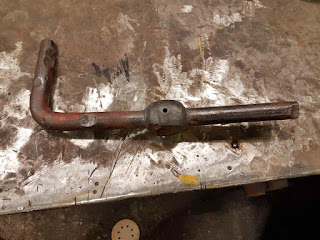Drawing, by Kerr Stuart,
Photos by Emily High and Rob Bishop
We have, at long last
reached the end of the frame repairs. At some stage in the past a
section of the front, drivers side frame was made removable, possibly
by Hunslets before the loco went to Mauritius. The Kerr Stuart frame
drawing has a note ‘see HECo’s (Hunslet
Engineering Co) drg No 30931 for alts to
frames of L4415’. We don’t have a copy of
that drawing, but the frames do not appear to have received any other
modifications. The removable panel can be seen in the photo below,
with the lay shaft bearing central in the panel.
When you see what is
behind the panel, the benefits of making it removable can be
appreciated.
The photograph above is
taken looking down into the frames from the front buffer beam,
driver's side and shows the components located on the layshaft. From
left to right can be seen the gear box, the front longitudinal frame
stretcher, the spur gears taking the drive from the gear box to the
lay shaft, the lay shaft chain sprocket (note the chain shaped wear
on the hole in the stretcher behind) and the transmission band brake.
All of this is contained behind the removable frame, and given that
the sleeve which contains the lay shaft extends for the full width of
the loco, getting at these components without the removable panel
must be a nightmare.
So, non-original it may
be, but retention is the way forward.
This is the frame
extension, with the holes being tidied up on the radial arm drill.
The holes have been
modified to take plough bolts; these have a counter sunk head,
but a
square on the shank to stop them turning when they are being
tightened.
The frames with the
removable plate re-fitted
Before the frame was
re-fitted an opportunity was taken to ream out the bracket
for the
transmission brake and fit a new pin.
The chains did nibble a good
bit out of the frames (top right)!
It is interesting that the opening
in the frames have been flame cut




















